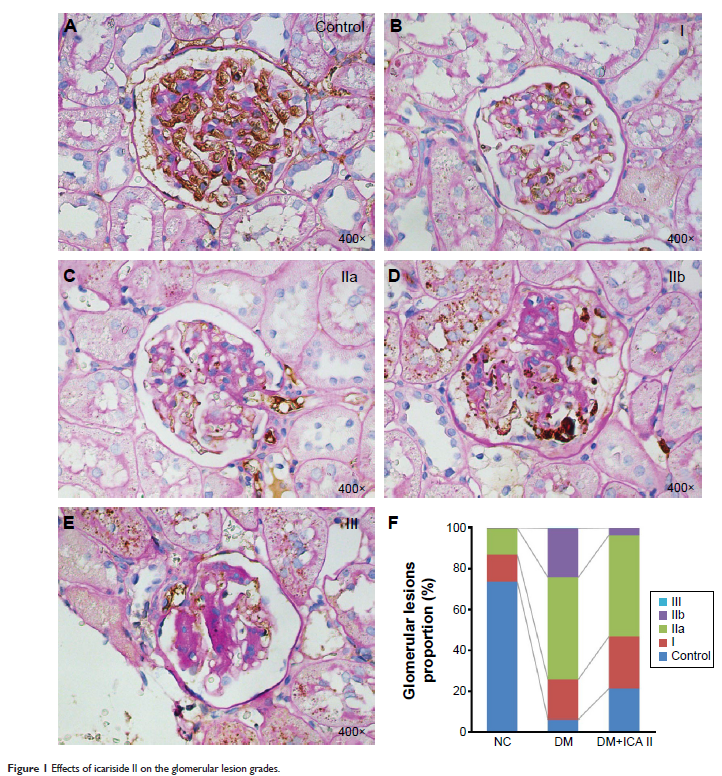9 0 5 7 8
论文已发表
注册即可获取德孚的最新动态
IF 收录期刊
- 2.6 Breast Cancer (Dove Med Press)
- 3.9 Clin Epidemiol
- 3.3 Cancer Manag Res
- 3.9 Infect Drug Resist
- 3.6 Clin Interv Aging
- 4.8 Drug Des Dev Ther
- 2.8 Int J Chronic Obstr
- 8.0 Int J Nanomed
- 2.3 Int J Women's Health
- 3.2 Neuropsych Dis Treat
- 4.0 OncoTargets Ther
- 2.2 Patient Prefer Adher
- 2.8 Ther Clin Risk Manag
- 2.7 J Pain Res
- 3.3 Diabet Metab Synd Ob
- 4.3 Psychol Res Behav Ma
- 3.4 Nat Sci Sleep
- 1.9 Pharmgenomics Pers Med
- 3.5 Risk Manag Healthc Policy
- 4.5 J Inflamm Res
- 2.3 Int J Gen Med
- 4.1 J Hepatocell Carcinoma
- 3.2 J Asthma Allergy
- 2.3 Clin Cosmet Investig Dermatol
- 3.3 J Multidiscip Healthc

淫羊藿次苷 II (Icariside II) 可改善患有链脲佐菌素 (Streptozotocin) 诱导糖尿病的大鼠的糖尿病性肾病
Authors Tian W, Lei H, Guan R, Xu Y, Li H, Wang L, Yang B, Gao Z, Xin Z
Received 7 June 2015
Accepted for publication 12 August 2015
Published 7 September 2015 Volume 2015:9 Pages 5147—5157
DOI http://dx.doi.org/10.2147/DDDT.S90060
Checked for plagiarism Yes
Review by Single-blind
Peer reviewers approved by Dr Rasika Samarasinghe
Peer reviewer comments 3
Editor who approved publication: Professor Shu-Feng Zhou
Purpose: To investigate the therapeutic effects and potential mechanisms of icariside II (ICA II) on reversing diabetic nephropathy in streptozotocin (STZ)-induced type I diabetic rats.
Methods: Newborn male Sprague Dawley rats were labeled with thymidine analog 5-ethynyl-2-deoxyuridine (EdU) for tracking endogenous label retaining progenitor cells (LRCs). At age of 8 weeks, 48 rats were randomly divided into three groups: normal control group (n=16), diabetes mellitus group (DM; n=16), and diabetes mellitus plus ICA II therapy group (DM+ICA II, n=16). Eight weeks induced for diabetes with STZ, rats in DM group and DM+ICA II group were treated with vehicle or ICA II (5 mg/kg/day) for another 8 weeks, respectively. Then, blood creatinine, 24-hour urine protein, blood urea nitrogen, and glycosylated hemoglobin were measured, as well as the expression of von Willebrand factor, malondialdehyde, transforming growth factor-β/drosophila mothers against decapentaplegic protein/connective tissue growth factor (TGF-β/Smad/CTGF) signaling, marker of proliferation Ki-67, and EdU+ LRCs in renal tissues.
Results: Increased levels of creatinine, 24-hour urine protein, and blood urea nitrogen and remarkably decreased proportion of normal glomeruli and increased proportions of I, IIa, IIb, and III glomeruli were observed in diabetic rats, while ICA II could reverse these changes. Interestingly, ICA II could significantly downregulate the levels of malondialdehyde and TGF-β/Smad/CTGF signaling and increase the expression of von Willebrand factor, Ki-67, and EdU+ LRCs in the kidney.
Conclusion: ICA II treatment could ameliorate diabetic nephropathy in STZ-induced diabetic rats by increasing endothelial cell contents, downregulating TGF-β/Smad/CTGF signaling pathway and oxidative stress level, and promoting cell proliferation both in kidney cortex and medulla. These beneficial effects appear to be mediated by its antioxidant capacity and recruitment of endogenous EdU+ progenitor cells into the kidney tissue.
Keywords: diabetic nephropathy, icariside II, EdU, diabetes mellitus, label retaining progenitor cells
